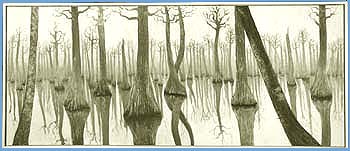![[MetroActive Arts]](/arts/gifs/art468.gif)
[ Arts Index | Metro Santa Cruz | MetroActive Central | Archives ]
Haunted Landscapes
 Eco-Art: Jennie McDade (whose painting is above) and Norman Locks explore the relationship between humans and nature at the Cabrillo College Gallery. In a show by UCSC visualists, nature and humans share an uneasy relationship with memory and desire By Christina Waters THE ECOLOGY OF memory receives its natural metaphor in the images filling the Cabrillo College Gallery this month. The recent works on display by painter Jennie McDade and photographer Norman Locks act as triggers of and testaments to a nostalgic state of candor. McDade's carefully worked oil paintings cast a wide-open eye on wilderness as both wild and tired, that territory once sought by baby boomers looking for eco-salvation. As McDade revisits her native Mississippi, her painter's eye tracks the forlorn vacancy of the swamps, their lethargic surrender to ugliness and decay. Cool gray-greens backlighted by fleshy pinks suggest a primeval beauty that her childhood memory--and eloquent brush strokes--keeps alive. In another piece, Death Valley, the flat golden splendor of desert isolation is eerily broken by the unexpected yet unmistakable image of a Stealth bomber. Painted in oil on board, this and other incantations of wilderness destroyed by human insolence suggest medieval altarpieces as well as David Lynchean topographic maps. Nature manages to hold its own against numbing brutality, McDade contends. The point is clear in the painting in which electrical towers anchor a Central Valley sunset like twin spires of a Gothic cathedral. Man is clearly the menace in McDade's world, setting hallucinogenic forest fires in one incendiary painting, yet failing to destroy the haunting loveliness of a solitary purple mountain. Decay and renewal seep through these finely worked pieces, whose classical format makes a compelling vehicle for their cautionary tales. McDade's images interweave effectively with the color photographs also on exhibit by Norman Locks, who has worked for many years in the Sierra wilderness region and increasingly explores those uneasy margins where forests and lakes give way to gas stations and billboards. Grouped to form internal dialogues and intertextual litanies, the photographs nonetheless resist disclosure, preferring to instantiate their own subject matter--indirect awareness and metaphysical muddle. Often textural contrasts, the sheer design work of branches and rocks, flowing water and still foliage distinguish pieces like Big Creek, Big Sur. Often the potential power of questioning juxtapositions is sabotaged by an insistence upon embedding two or three photographs within a single mat. And just as often, the color of the images obfuscates the power of the artistic message--we cannot see the point through the blur of color. One wonders just how much more eloquent some of these pieces would be in black-and-white, where the manifold shades of green would be "silent" and let the artist's vision show through. Overall the show rewards multiple viewings, bringing us back time and again to our own encounters with the darkness at the edge of town, of the forests and landscapes of our remembered youth. Destruction and regeneration, on scales both vast and intimate, heroic and mundane, form the unifying theme. Locks hems in a slice of pristine meadow with two menacing logging trucks. McDade revisits cypresses hung with ghostly Spanish moss--languid and putrid--and reveals her astonishment at how quickly it's all disappearing into dust. Cycles and Change reverses the activist mantra and gives us the political as the personal. It's a beautifully disturbing vista--and one that we recognize all too well.
Cycles and Change, Trails and Journeys, paintings and photographs by Jennie McDade and Norman Locks, is now on display at Cabrillo College Gallery through April 16. For info, call 479-6308. [ Santa Cruz Week | MetroActive Central | Archives ]
|
From the March 24-31, 1999 issue of Metro Santa Cruz.
Copyright © Metro Publishing Inc. Maintained by Boulevards New Media.